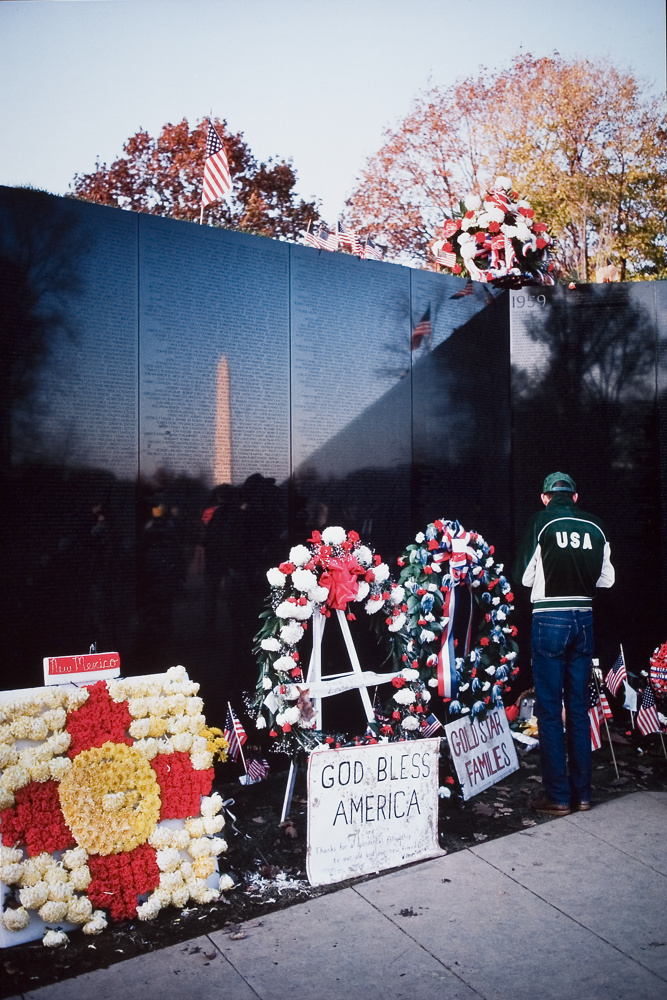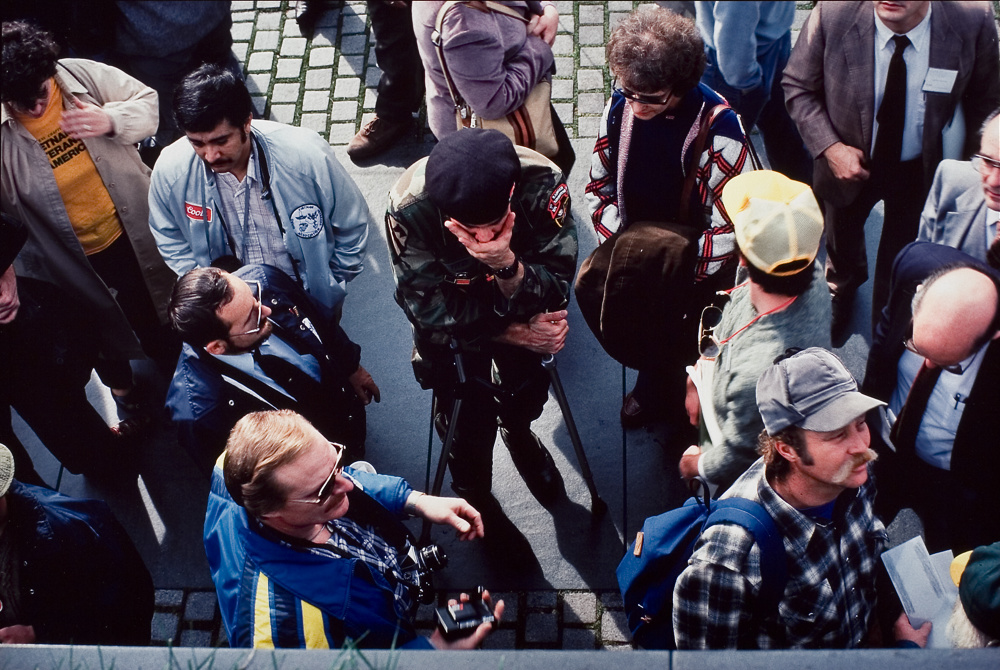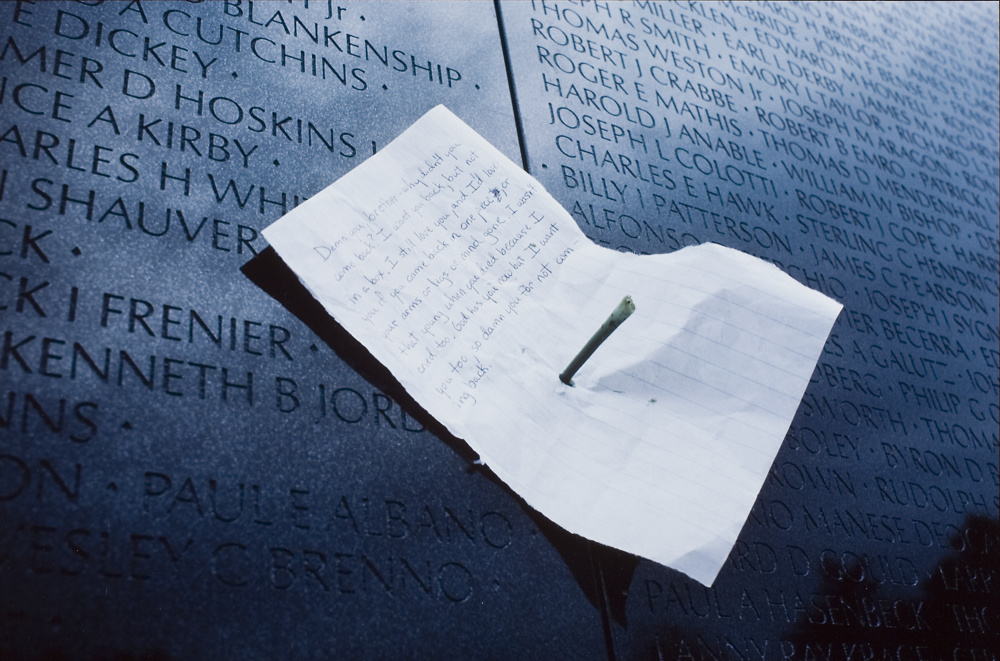- Open today, 10 am to 5 pm.
- Parking & Directions
- Free Admission
Object of the Week: Vietnam Veterans Memorial

Salvatore (Sal) Lopes, (American, b. 1943), Dedication Day from the series Vietnam Veterans Memorial, November 1982, Cibachrome print (photograph), Museum purchase, 87.351
Sal Lopes spent five years photographing the Vietnam Veterans Memorial in Washington, D.C. after its unveiling in 1982. This body of work, first presented at the Chrysler in 1987, is much more than a document of the Wall. In image after image of people carrying out rituals of mourning and remembrance, the series becomes its own monument to memory. A testament to veterans and their experience, the photographs also offer a commentary on how meditating on loss helps us heal and create a sense of community. As we approach Memorial Day during a time of deep division and incalculable loss, the spirit Lopes captures may serve as a guide.
Although widely admired today, the Wall was at first controversial. Designed by Maya Lin, the structure is more than 500-feet long and made of black granite polished to near-mirror finish and etched with the names of more than 58,000 Americans who perished or went missing in the Vietnam War. Built along a descending pathway, the Wall forms a bent hyphen that connects two other memorials on the National Mall: the Washington Monument in one direction and the Lincoln Memorial in the other. Sinking into the ground, made of dark stone, and lacking representational details, the Wall is a striking counterbalance to its stately and triumphant neighbors.

Salvatore (Sal) Lopes, (American, b. 1943), Untitled from the series Vietnam Veterans Memorial, November 1986, Cibachrome print (photograph), Museum purchase, 87.349
When the Wall was being planned, outraged critics testified before the U.S. Commission of Fine Arts, calling it “a black gash of shame” and insisting that it only reinforced the wounds veterans felt about the controversial war and the lack of support they felt after. A compromise was reached when another artist was selected to design a representational sculpture, The Three Servicemen, which was eventually installed near the entrance to the Wall. A third component, a monument to the women who served in the war, was added in the 1990s.
Despite the initial concerns, Lin’s original plan was largely maintained, and with striking results. As Lopes’s photographs confirm, when people began to visit the Wall, they enacted rituals of remembrance that helped them mourn the war and its many losses. Descending the path, touching the Wall, taking rubbings of names, and leaving objects to commemorate loved ones, each visitor becomes, in Lopes’s words, “a pilgrim” who spontaneously shares their tragic memories.

Salvatore (Sal) Lopes, American, b. 1943, Over West Wall from the series Vietnam Veterans Memorial, November 1984, Cibachrome print (photograph), Museum purchase, 87.360
This ritual of collective mourning is what defined Memorial Day when it was first recognized after the Civil War. Originally known as Decoration Day, individuals would express their grief with those around them by decorating the graves of fallen soldiers. By publicly sharing common feelings, the observance was meant to bring people together, drawing them into a structure of feeling that reinforces the idea that there is more that binds us than divides us.

Salvatore (Sal) Lopes, (American, b. 1943), Untitled from the series Vietnam Veterans Memorial, November 1984, Cibachrome print (photograph), Museum purchase, 87.363
Lopes’s photographs bring these powerful emotions to mind and reinforce them. Some images concentrate on the objects visitors leave behind such as flowers, wreaths, badges, photographs, and personal notes. One letter Lopes photographed poignantly reads “Damn you, brother— why didn’t you come back?…I still love you.” To date, people have left more than 400,000 commemorative items that have been preserved in the collection of the National Park Service. Other photographs show veterans, people in suits, and tourists—all strangers to one another— standing shoulder to shoulder as they collectively mediate on loss. As Lopes recalls, these experiences are often intense. One of his photographs shows a veteran who collapsed in sorrow. A woman he did not know swept up the distressed soldier in her arms, joining him in his grief as they pressed their faces against the Wall. The photograph is a powerful reminder that loss is something we all have in common and something that can bring us together despite our deep differences. As Lopes photographs may help us realize on this Memorial Day, dwelling on our losses may be one way to unite us.

Salvatore (Sal) Lopes, (American, b. 1943), Vietnam Memorial (Letter – “Why Didn’t You Come Home?”) from the series Vietnam Veterans Memorial, November 1986, Cibachrome print (photograph), gift of the artist, 91.34
–Seth Feman, Deputy Director for Art & Interpretation and Curator of Photography

